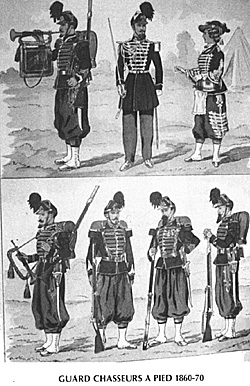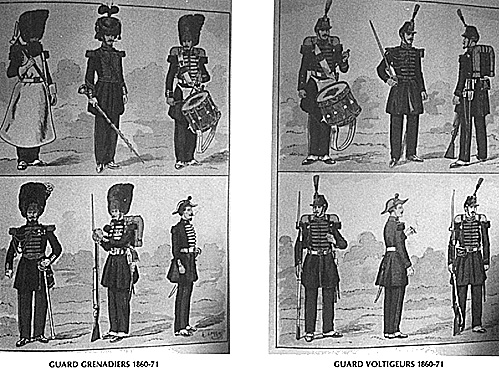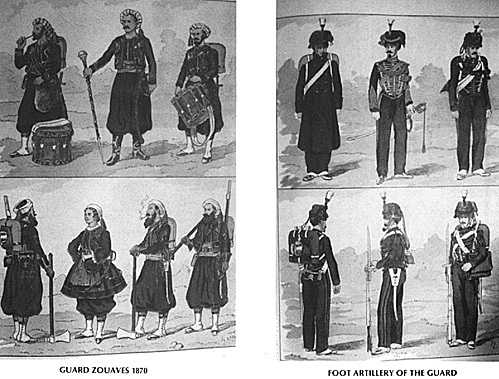 The Imperial Guard infantry was very numerous and imposing in appearance. included were Grenadiers, Voltiguers, Chasseurs, and an entirely new wrinkle, Zouaves.
The Imperial Guard infantry was very numerous and imposing in appearance. included were Grenadiers, Voltiguers, Chasseurs, and an entirely new wrinkle, Zouaves.
Guard Chasseurs a Pied, 1860-70
The Grenadiers, 3 regiments each 3 battalions strong, were if anything more imposing than Uncle Napoleon's equivalent. The full bearskin was worn in both parade and initially, on the battlefield. A long tailed blue coat with red turnbacks sporting white grenades, white plastron, and brass buttons was normal dress. On parade the bearskin with its white cording and red plume had a small white grenade at the top. The brass plate had an engraved imperial eagle, and the chin scales were brass.
Originally the trousers were blue, but before any Guardsmen went to war they had been changed to the familiar pantalon rouge of the day. Cuffs were red, cuff flaps of the Brandenburg style of white with 3 brass buttons. Armament consisted of a minie rifle, angular bayonet and saber briquet.
The Guard Voltigeurs, who theoretically had no precedent, should actually be compared to the various formations of Guard Chasseurs a Pied of Uncle Napoleon. They were nominally light infantry, and originally drew from the light infantry regiments who convered to line infantry in 1855. Except for the tapered shako with brass eagle and white cording, yellow collar, and yellow turnbacks, blue cuffs with yellow light infantry piping, these troops, numbering 4 regiments of 3 battalions each, were similarly dressed to the Guard Grenadiers. On parade they wore yellow plumes with a red base, and their red epaulettes had a yellow crescent unlike the solid red of the Grenadiers.
When they went to war in 1859 the Guards were in the thick of the fighting at both Magenta and Solferino. In the field the shako and bearskin were retained, but the plumes and cording generally were not, and a dark blue gray (some say darker blue) overcoat without colored collar or cuffs was worn, as shown by the bottom center Grenadier figure. Thus clothed, the Grenadier Division crossed the Ticino and Grand Canal against light opposition the day before Magenta, where they held out supported by a guard battery and the Chasseurs a Cheval for the whole day until the Voltigeur Division and other French troops arrived by flank march.
Since the Grenadiers numbered a regiment less than the Voltigeurs, they were augmented by a two battalion regiment of Zouaves of the Guard. These were described in the article on line zouaves, and were distinguished mainly by their royal blue false pocket.
The Voltigeur Division was augmented by a single battalion Chasseur a Pied de la Garde unit. This unit was nominally the inheritor of the traditions of the Chasseurs a Pied of Uncle Napoleon's Guard. In fact, it was a direct inspiration of the Chasseurs d'Orleans, whose resulting field battalions of elite light infantry provided drafts for the Guard units. The latter had the familiar dark blue coat, silver buttons, and black belting with blue gray trousers of the line units.
However, it differed in having Hungarian lace on the side of the full trousers, and a natty little jackets which, while no problem for the Guard Chasseurs, was considered the bane of the rest of the army when it was issued to them in 1860. Guard Chasseurs often wore the short shako with yellow trim and green plume (later red topped) in the field, and were the first Guard unit to see action, taking part in the seige ofSevastopol where they distinguished themselves by seizing a strong Russian position and nearly getting wiped out in the process.
When the rest of the army adopted the same cut of coat as the Guard Chasseurs, the Grenadiers and Voltigeurs adopted the hip length tunic with white lace for the Grenadiers, yellow for the Voltigeurs. There was little change to the Zouaves or Chasseurs, except that the black scabbards of the saber bayonets somewhere along the line became polished steel.
Illustrations
Top: (left:) GUARD GRENADIERS 1860-71 and (right:) GUARD VOLTIGUERS 1860-71.

Top: (left:) GUARD ZOUAVES 1870 and (right:) FOOT ARTILLERY OF THE GUARD.

More Napoleon III Imperial Guard
Back to Table of Contents -- Courier Vol. VII #3
To Courier List of Issues
To MagWeb Master Magazine List
© Copyright 1986 by The Courier Publishing Company.
This article appears in MagWeb (Magazine Web) on the Internet World Wide Web.
Other military history articles and gaming articles are available at http://www.magweb.com